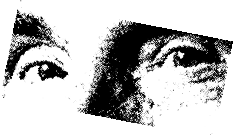Black Holes, Black Splatters
A unison of foreign reference and self-reference in the paintings of Frederick Bunsen
Niklas Luhmann 1995

• Frederick Bunsen
• William Hogarth, 1697-1764
• System Theory
• Art and Language group
• non-picture in a picture
• German Translation
• Spanish Translation
• Zurück zum Index und Hauptverzeichnis
"...Die Farbe Schwarz allein kann das wohl nicht entscheiden": Niklas Luhmann
Ever since the discovery of perspective or other techniques involving color, pictures - figurative or abstract - have had the ability to relay the impression of space, and hence, require no further remark.
Accordingly, space is just a recurrence of that which (or how) we actually see anyway. Then again, when dealing with "depth" more is actually required than simply that. Still, can another form of depth successfully operate if our related concepts of space are bound on the habit of perspective seeing, and indeed don't expect otherwise of a picture's space? In other words, are there other forms of depth than that of space; or other ways to bring it into a picture other than using perspective?
The reader needs only recall the art of ornament which underscores the importance of the object on which it´s fixed. The intention here was: the exterior surface interprets the inner depth. Divination techniques for older civilizations along with diverse lineament on turtle shells, in animal entrails, in flights of birds - taken as a sign of mystery - must have been a familiar way of thinking. Thus, depth wasn´t only spatial distance, inasmuch as the contrary, invisible side of the range of sight. The renaissance school of disegno - up until its deconstruction - took up the idea again, to the extent of Hogarth's interpretation, that a line, vigourous drawn, reveals how the art work sees itself from the inside out. In those days beauty was formerly described as balanced proportion, and was therefore challenged with the question, for what other purpose disegno, linear beauty, arabesque, or ornament could serve - if not, at least to conceal weaker points in an art work.
Once again the question: Are there other possibilities for making depth discernible? And how might it be, if indeed, the significance of depth didn't have to do simply with distance?
Frederick Bunsen experiments with "black holes", which in the modern cosmology are coordinates in the cosmos (in the cosmos there are indeed other things besides depth), whose gravity silently gulps everything that comes near it. Black and silent, for neither light nor tone ever return. But how can such black holes even be brought into a picture? Color alone can't determine it.
Perhaps it's helpful to discriminate between black holes und black splatters, and then to ask: how does one know that he/she is dealing with a hole and not with a splatter? Splatters like holes make reference to something outside the picture, to something that in itself is not to be seen; and as stated, not only refers to the continuing, always continuing expansion of the picture space. Black holes should actually suck themselves into the picture, and not act like a hole in the wall which leads out the back. If the metaphor is taken seriously, they (the black holes) wouldn't be just a picture in a picture, but instead, the non-picture in the picture.
But a picture has to stay a picture: it has to retain the black in the picture, especially if it wants to relay more than that of a mere component in the picture's composition. In terms of the System Theory, it must have attained the oneness of foreign-reference und self- reference, of "towards the outside" and "towards the inside", all contained in the picture itself (and nowhere else). As far as splatters are concerned it doesn't seem to be all too difficult: Being splatted is to make apparent through the contour of the splatters, which, like squirts, allows discernment of the not-being-planned in the contours. And the splatters are contained all over again, in that they are networked into the picture, for example, by use of lines which in part cross over the splatter, or in part, fall behind them: or through a kind of filigree lineament that let splatters emerge by contrast, and hence are retained in the picture. The technique of to retain-in-the-picture remains in itself invisible, that is, not-to-be-seen, to express it in terms of the English Art and Language group. They infer entirely from the analyses in the mode of 2. level observation (Beobachtung 2. Ordnung). Yet how can black holes be retained in the picture without having them transformed to mere black planes, and in so doing robbing them of their black hole character?
If these thoughts are applicable, two problems of definition (Abgrenzungsprobleme) arise that must be solved if black holes should become a picture issue: that of their pure spatial depth, and that of the splatters. Truly: how can traversing the usual forced way of thinking be avoided? How can the non-picture be retained in the picture and be made visible?
A commentary can rightly define problems, but never anticipate the artist, nor prescribe solutions to a problem. Nevertheless, another differentiation has made itself evident through the preceding essay. A graphic framework seems to be better qualified in establishing black planes as splatters in a picture. Color implementations could be more helpful if black is to be observed as a black hole.
Then, other colors have the possibility of allotting black the quality of color - or to decline it, and let appear as a colorless, all-color-absorbing, black.
Epilog: I'm not that pleased with the term "picture", but it can't be substituted.
© 2001